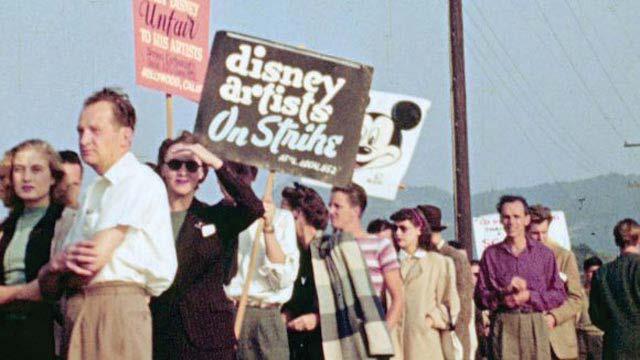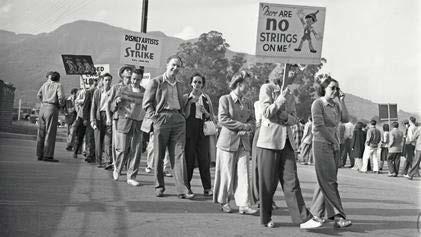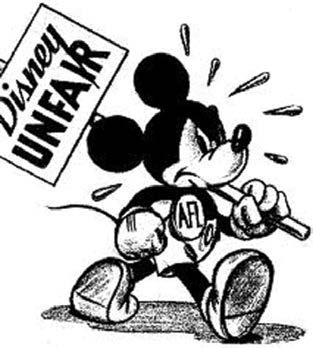
7 minute read
The Strike That Shifted the Landscape
The new book The Disney Revolt: The
Great Labor War of Animation’s Golden
Age by animation historian Jake S. Friedman, chronicles the union war fought by animator Art Babbitt and the animators’ strike of 1941. Walt Disney responded to the five-week strike by firing many of his animators, but he was eventually pressured into recognizing the Screen Cartoonist’s Guild. In this excerpt, Friedman describes the first morning of the strike, following Babbitt, labor leader Herb Sorrell and head of the independent union Bill Littlejohn. [From Chapter 25]
The press called them “loyalists.” But there were many reasons why hundreds of non-striking Disney artists drove to work the morning of May 28, 1941. Dumbo and Bambi would not be completed without them. They also shared a gratitude toward Walt, who not only had hired them during the Depression but also had provided them with an opulent new studio. Besides, what kind of tyrant insisted on being addressed by his first name? The first thing they noticed as they approached the studio was a seemingly endless line of cars parked by the curb leading to the front gate. What they saw at the Disney entrance was a spectacle they had not anticipated.
About 500 men and women were on their feet, walking in a large circle in front of the entrance. Nearly one in 10 carried wooden picket signs, many painted with cartoon characters.
It’s Not Cricket to Pass a Picket, warned
Jiminy Cricket.
I’d Rather Be a Dog Than a Scab, chided
Pluto.
I Sign Your Drawings / You Sign Your Lives, taunted a caricature of Walt.
Michelangelo, Raphael, Leonardo da Vinci,
Rubens, Rembrandt All Belonged to Guilds.
The number 600 showed up a few times, too, referring to the total number of Disney artists. A strike handout reported that one sign read, One Genius Against 600 Guinea Pigs. Another had, Snow White and the 600 Dwarfs. Traffic entering the studio slowed to a crawl. As each car inched through, the strikers hooted and hollered, calling each strikebreaker a “scab” and a “fink.” A sound truck was parked nearby, providing a portable PA system to the person at the microphone. Bystanders and non-strikers were handed flyers titled An Appeal to Reason — its title borrowed from the Socialist periodical that Walt’s father used to read.
“The salaries of the Disney artists average less than those of house painters,” read a press bulletin. “The Disney girl inkers and painters receive between $16 and $20 a week. On Snow White, the much-publicized bonuses did not even compensate the artists for the two years of overtime they worked. Snow White made the highest box office gross in history — over $10,000,000.00. All the other major cartoon studios in Hollywood have Screen Cartoon Guild contracts. The Disney Studio is the only nonunion studio in Hollywood.” The strikers were demanding a 10 percent wage increase across the board, a 25 percent wage increase for the lower bracketed artists and the reinstatement of the 19 animators — including Babbitt — who they argued were fired for union activity.
The Disney carpenters, machinists, teamsters and culinary workers refused to cross the picket line. Electricians, cameramen, sound men and film editors also refused. One striker photographed each “scab” who drove through. Atop a hill in the eucalyptus knoll across the street, a striker in a beret and smock stood at an easel painting a landscape of the ordeal. On the ground, there were “guys pouring their individual speeches into the ears of those on the fence,” wrote one non-striker that day. “I was struck with the magnitude of it all.” “The average age was less than 25,” said Herb Sorrell in 1948. “They became the most enthusiastic strikers I have ever seen in my life.” Some strikers leaped onto car bumpers; others rocked cars side to side. Once embattled drivers were through the gates, they were greeted with cheers and claps from a welcoming committee of non-striking inkers and painters.
The strikers had each been given two- or three-hour shifts, ensuring a 24-hour picket line. They were mostly in-betweeners, animation assistants, inkers and painters, but among them were also story artists, effects artists, background painters and animators. Bill Tytla and Art Babbitt stood out as the highest paid on strike.
The previous night, the Guild had voted to include supervising animators among its membership. This made not only Babbitt and Tytla eligible to strike, but also all other top animators. Babbitt was on his feet rallying alongside the other strikers, shouting to non-strikers by name, including Ward Kimball. “I felt terrible,” Kimball journaled that day. “Friends on the inside waving to me to come in. Friends on the outside pleading with me to stay out; Jeezus. I was on the spot!”

Workers vs. the Mouse: The box-office failures of Pinocchio and Fantasia in 1940 forced layoffs at Disney, which were followed by the animators’ strike over inequities of pay and privileges at the non-unionized studio.




Inside the studio, loyalists were worried. “How the hell can Walt run a studio without us?” asked Norm Ferguson. As non-strikers passed the gauntlet of pickets, strikers warned them that once the union won, it would fine them an amount equal to their salary plus $5 per day, plus a $100 penalty. Ferguson told his fellow non-strikers, “Any agreement made will have to involve protection for you guys or Walt wouldn’t sign, so stay on and receive your salary!” With nearly all the assistants and in-betweeners outside, the animators pitched in to do those jobs for each other. If the films weren’t completed, the Bank of America might foreclose. Right now, everything was riding on Dumbo, the studio’s “B” picture.
Relationships were severed. It was the end of Babbitt’s friendships with non-striking animators Les Clark and Fred Moore. Babbitt was also dating a blonde secretary named Nora Cochran before the strike; she was unsympathetic.
The strike took its toll on those who couldn’t choose a side. Novice animator Walt Kelly (future creator of the comic strip Pogo) had friends on both sides, and he packed up and left altogether. He claimed it was to care for his ill sister, but privately he left his friends this note:
For years I have reached for the moon
But the business now is in roon
So I don’t hesitate
To state that my fate
Is to take a fug of a scroon!
After 10 a.m., the strikers dispersed to the adjacent eucalyptus knoll. Sorrell recalled that “from 10 to 11 or 11:30, we would talk to them on a loudspeaker system, and of course they could hear in Disney’s what we were saying across the street.”
Every emphatic slur and enthusiastic cheer that erupted from the PA system echoed in the Burbank studio. Walt was still seen smiling at lunchtime. “I’m going to see this to the end,” he said. “I told ’em I’m willing to hold an election, but they refuse, it’s their funeral!” Walt was fixated on having a secret-ballot vote to determine the majority, but there was good reason for the Guild to deny an election. The Disney company, it was rumored, was fudging the numbers, counting its non-artist employees as artists. The studio released a statement that there were only 309 absences out of 1,214 total employees that day, and that there would have been fewer if not for the threat of union goons. The strikers knew that of those 1,214, there were hundreds of employees — from accounting to security — who were ineligible for an animators’ union.
In truth, no one seemed to agree on how many artists were on strike and how many were not. Bill Littlejohn figured 450 strikers out of 580 artists, while Babbitt counted 375 strikers out of 550 artists. The Disney strikers also reinforced their numbers with spouses and friends on the picket line. In actuality, it was an extremely balanced divide, with roughly 330 strikers out of roughly 602 artists. (The evenness of the split was confirmed later by the Guild’s business agent.) It was what made the strike so adversarial. If just 20 strikers changed their vote in the heat of a company-led election, the union would lose.











